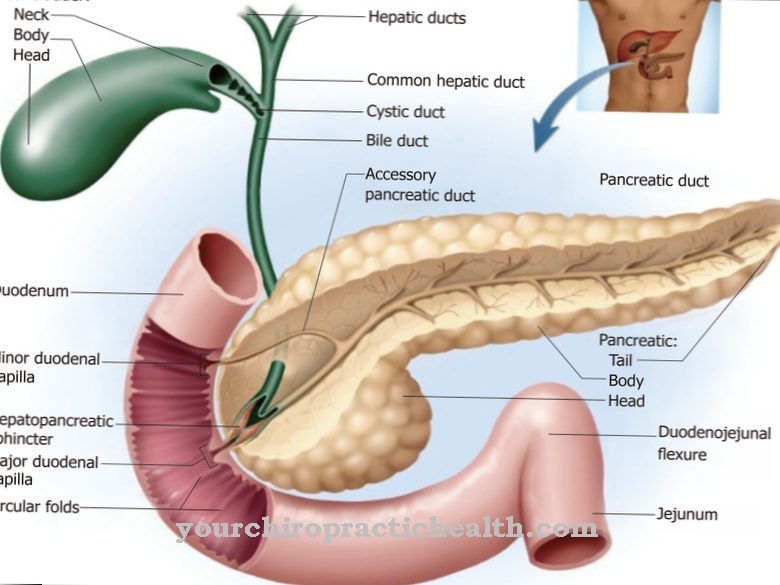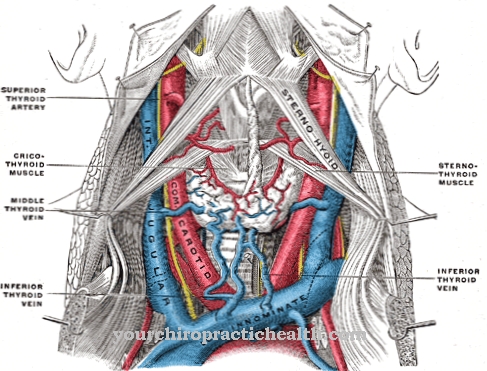Of the Parasympathetic nervous system is the part of the vegetative nervous system that ensures rest and relaxation in the body. It affects a large number of internal organs. The parasympathetic nervous system coordinates the functions of the organs in such a way that the entire body can slide into a state of relaxation.
What is the parasympathetic nervous system?

The parasympathetic nerve is the body's resting nerve. Together with the sympathetic nervous system, it forms the vegetative nervous system. As part of the autonomic nervous system, the parasympathetic nervous system cannot be willingly influenced. It independently controls those processes in the body that are related to relaxation, rest and protection.
Metabolism and heartbeat slow down under the influence of the resting nerve. At the same time, activities are encouraged that the body carries out at rest, such as digestion and relaxed observation of the environment.
Nerve fibers of the resting nerve connect the brain stem and the cross part of the spinal cord with various internal organs. Communication takes place in both directions: information from the organs reaches the brain and spinal cord via nerve fibers. The brain and spinal cord send information to the organs. Both internal and external impulses can activate or deactivate the parasympathetic nervous system.
The parasympathetic nervous system is the antagonist of the sympathetic nervous system, which ensures increased activity and increased performance in the body.
Anatomy & structure
The nerves of the parasympathetic nerve emerge from the brain stem (midbrain and medulla oblongata) and the cross part of the spinal cord. They are therefore also summarized under the term craniosacral system.
The nerve fibers of the brain stem affect the internal muscles of the eyes, as well as the salivary and lacrimal glands. The largest nerve of the parasympathetic system, the tenth cranial nerve, continues to originate from the brain stem. It is very long and affects the function of most internal organs.
The area of influence of the tenth cranial nerve is very extensive. It extends to the last third of the colon. From the so-called Cannon-Böhm point, nerve fibers, which originate in the cross part of the spinal cord, supply the large intestine. They continue to supply nerves to the bladder and genitals. The Cannon-Böhm point is not an exact point. It is a transition zone in which nerves from the brain stem as well as from the cross part of the spinal cord supply the large intestine.
Function & tasks
The parasympathetic nervous system ensures that the body recovers. It does this through a series of processes initiated by the parasympathetic nervous system. The resting nerve stimulates the production of secretions and fluids in the lacrimal and salivary glands as well as in the bronchi and the digestive tract.
The body excretes toxins through the tear fluid. The bronchi narrow and the build-up of mucus increases as the need for oxygen decreases. Increased saliva production prepares the body for food intake.
The further digestion of the food is aided by the fact that the parasympathetic nervous system stimulates the intestinal activity. Increased bowel movements support digestion, as does the increased secretion of glands in the digestive organs. The rest nerve causes the bladder to empty and promotes defecation.
The heartbeat slows down under the influence of the parasympathetic nervous system. Blood pressure also drops. In the area of the genitals, the vessels expand. The rest nerve continues to cause the pupils to constrict. This causes the depth of field to increase. A good all-round view enables a precise understanding of the environment, which allows details to be recognized.
Illnesses & ailments
Normally there is a balance between the sympathetic and parasympathetic nervous systems in the body. Both states of the autonomic nervous system usually occur one after the other and inhibit the other. This means that an active phase (sympathetic) is followed by a passive, relaxed phase (parasympathetic).
If the balance is disturbed, it can lead to vegetative dystonia. Communication between the brain and the autonomic nervous system is disturbed, which is why the sympathetic and parasympathetic nervous systems cannot create a balance between activity and relaxation in the body. Since the autonomic nervous system influences all organs of the body, disturbances are the result, which can occur in all organs and body regions.
Symptoms include insomnia, muscle cramps, headache, digestive system discomfort, heart problems, nervousness and difficulty breathing. The complaints are of a functional nature and not based on organic disorders. This may make it difficult to make a diagnosis. The triggers are usually long-term stress and emotional strain.
Shifting the balance only towards the parasympathetic nervous system can lead to vagotonia (parasympathiconia). The blood pressure is consistently very low, the pulse is slow, the pupils are constricted, and feet and hands are cold. The person concerned suffers from general listlessness and has problems with actively shaping his life.
People who do frequent cardio exercise also tend to have vagotonia. Vagotonia caused by exercise is not pathological. In contrast to pathological vagotonia, it does not include the symptom of listlessness.












.jpg)



.jpg)










.jpg)
